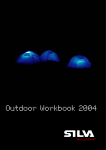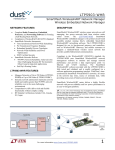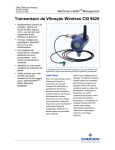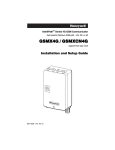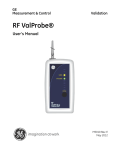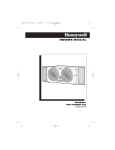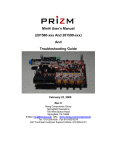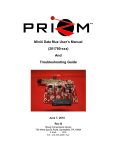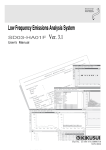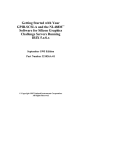Download Datasheet LTP5900
Transcript
S M A R T M E S H® W I R E L E S S H A R T L T P 5 9 0 0 - W H M 2.4 GHz 802.15.4 Wireless Mote About SmartMesh WirelessHART Dust Networks’ SmartMesh® WirelessHART is an industry-leading wireless networking solution designed for critical monitoring and control applications. WirelessHART serves a wide range of applications from renewable energy generation, such as solar and wind power, to factory machine health monitoring and data center HVAC energy management. The SmartMesh WirelessHART system delivers dynamic network optimization and intelligent routing to achieve unsurpassed levels of wireless network scalability, system-wide reliability and low latency, coupled with industrial-class security. Additionally, ultra-low power operation permits even greater deployment flexibility for wire-free applications. Product Description—LTP5900 The LTP5900 mote module combines Dust Networks’ robust sensor networking solution breakthrough EternaTM SoC technology in an easy-to-integrate 22-pin module. As part of the SmartMesh WirelessHART system, the LTP5900 enables customers to integrate a standards-based wireless network into sensors and actuators to provide scalable bidirectional communications. The LTP5900 is designed for use in line-powered, battery-powered, or energy-scavenging sensor and actuator applications that demand reliable performance and ultra-low power operation. With Dust Networks’ innovative IEEE 802.15.4-compliant design and integrated power amplifier, the LTP5900 enables a decade of battery life on two AA batteries. All motes function as wireless routers, enabling a redundant, high performance, full-mesh topology. The LTP5900 integrates all radio circuitry components, including an MMCX-type antenna connector to eliminate the need for complex RF design. To accelerate customer development time and reduce development costs, Dust Networks provides a fully engineered RF solution, comprehensive APIs, and complete development documentation. Key Product Features WirelessHART Compliance • Interoperable with WirelessHART Devices Highly Scalable • Automatic network formation—new motes join automatically from anywhere in the network • All motes are wireless routers, providing a full-mesh network that easily scales to tens of thousands of motes per square km • Time-synchronized communication across 15 channels virtually eliminates in-network collisions, allowing for dense deployments in overlapping radio space Superior Reliability • SmartMesh WirelessHART Intelligent Networking Platform enables greater than 99.99% network reliability even in the most challenging monitoring and control environments • Time-synchronized channel hopping minimizes the impact of crippling multipath interference in dynamic RF environments LTP5900 Mote Datasheet Dust Networks Ultra-low Power Operation • Industry-leading radio technology capable of line-powered, battery-powered, or energy-scavenging operation • Automatic network-wide coordination optimizes power consumption, enabling a decade of network operation on two Lithium AA batteries Easy to Integrate and Deploy • Fully engineered RF, with power amplifier (PA), balun, crystals, antenna matching circuitry and antenna connector • Comprehensive APIs provide rich and flexible functionality to ease software development and device integration Secure Global Market Solution • Fully engineered RF, with power amplifier (PA), balun, crystals, and antenna matching circuitry • AES-128 bit encryption 1 Table of Contents 1.0 Absolute Maximum Ratings ................................................................................4 2.0 Normal Operating Conditions .............................................................................4 3.0 Electrical Specifications .....................................................................................5 4.0 Radio..................................................................................................................5 4.1 Detailed Radio Specifications ................................................................................ 5 4.2 Antenna Specifications......................................................................................... 6 5.0 Pinout ................................................................................................................6 5.1 LTP5900 Pinout................................................................................................... 6 6.0 Power Supply Design .........................................................................................8 7.0 Mote Boot Up......................................................................................................8 7.1 Power-on Sequence............................................................................................. 8 7.2 Inrush Current.................................................................................................... 8 7.3 Mote Boot Sequence............................................................................................ 9 7.4 Serial Interface Boot Up ......................................................................................10 7.4.1 LTP5900 Serial Interface Boot Up ...................................................................10 8.0 Interfaces ........................................................................................................10 8.1 Reset Pin ..........................................................................................................10 8.2 Timestamps ......................................................................................................10 8.3 Settable I/O Modes ............................................................................................11 8.3.1 Mode 1: Three/Four/Five-signal Serial Interface (9600 bps) ...............................11 8.3.2 Mode 3: Five-signal Serial Interface (115.2 kbps) .............................................12 8.3.3 UART AC Timing ..........................................................................................13 8.4 Mote Serial API ..................................................................................................15 8.5 Temperature Sensor...........................................................................................15 9.0 Packaging Description......................................................................................16 9.1 Mechanical Drawing............................................................................................16 9.2 Soldering Information .........................................................................................17 10.0 Regulatory and Standards Compliance .............................................................17 10.1 FCC Compliance...........................................................................................17 10.1.1 FCC Testing ................................................................................................17 10.1.2 FCC-approved Antennae ...............................................................................18 10.1.3 OEM Labeling Requirements ..........................................................................18 10.2 Industry Canada (IC) Compliance...................................................................18 10.2.1 IC Testing...................................................................................................18 10.2.2 IC-approved Antennae..................................................................................18 10.2.3 OEM Labeling Requirements ..........................................................................18 10.3 CE Compliance ............................................................................................19 10.3.1 Declaration of Conformity .............................................................................19 10.3.2 European Compliance ...................................................................................19 10.3.3 OEM Labeling Requirements ..........................................................................19 2 Dust Networks LTP5900 Mote Datasheet 10.3.4 Restrictions.................................................................................................19 10.4 Compliance to Restriction of Hazardous Substances (RoHS) ...............................19 10.5 Industrial Environment Operation...................................................................20 10.6 Encryption Cipher ........................................................................................20 11.0 Related Documentation ....................................................................................20 12.0 Order Information............................................................................................20 LTP5900 Mote Datasheet Dust Networks 3 1.0 Absolute Maximum Ratings The absolute maximum ratings shown below should not be violated under any circumstances. Permanent damage to the device may be caused by exceeding one or more of these parameters. Unless otherwise noted, all voltages in Table 1 are made relative to VSS. Table 1 Absolute Maximum Ratings Parameter Min Typ Max Units Supply voltage (VDD to VSS) –0.3 3.76 V Voltage on any digital I/O pin –0.3 VDD + 0.3 V Comments up to 3.6 Input RF level Input power at antenna connector 10 dBm +85 °C Lead temperature +245 °C For 10 seconds VSWR of antenna 3:1 ±8000 V HBM ±2 kV HBM ±200 V CDM Storage temperature range –40 ESD protection Antenna pad All other pads Caution! ESD sensitive device. Precaution should be used when handling the device to prevent permanent damage. 2.0 Normal Operating Conditions Unless otherwise noted, Table 2 assumes VDD is 3.6 V and temperature is 25 °C. Table 2 Normal Operating Conditions Parameter Operational supply voltage range (between VDD and VSS) Min Typ Max Units 3.76 V 200 mVp-p 50 Hz to 2 MHz 1.5 V Reset trip point 4.4 mA Searching for network, typically 150 ms on and 2850 ms in doze* mA max 750 uS + VDD rise time from 1 V to 1.9 V. mA TX, 5 ms maximum mA TX, 5 ms maximum, +85 °C, 3.3 V mA TX, 5 ms maximum 1.5 uA ¯¯¯ asserted, following PoR RST completion +85 °C 8 °C/min -40 °C to +85 °C 90 % RH Non-condensing 2.75 Voltage supply noise Voltage supervisor trip point Comments Including noise and load regulation Peak current During Power on Reset 12 Power amplifier enabled 9.5 Power amplifier enabled 12 Power amplifier disabled 5.2 Reset Operating temperatures -40 Maximum allowed temperature ramp during operation Operating relative humidity 10 * The duration of doze time and “on” time is determined by the joinDutyCycle command in the mote serial API. Refer to the SmartMesh IA-510 Mote Serial API Guide for details. 4 Dust Networks LTP5900 Mote Datasheet Unless otherwise noted, Table 3 assumes VDD is 3.6 V. Table 3 Current Consumption Parameter Min Typ Max Units Comments Transmit Power amplifier enabled 9.5 mA Power amplifier disabled 5.2 mA 4.4 mA Receive 3.0 Table 4 Electrical Specifications Device Load Parameter Min Typ Max Units Comments Total capacitance 6 µF VDD to VSS Total inductance 4.9 µH VDD to VSS Unless otherwise noted, VDD is 3.6 V and temperature is –40 °C to +85 °C. Table 5 Digital I/O Type 1 Digital Signal Min Typ Max Units VIL (low-level input voltage) –0.3 0.6 V VIH (high-level input voltage) VDD-0.3 VDD + 0.3 V VOL (low-level output voltage) VOH (high-level output voltage) 0.4 VDD-0.3 Input leakage current 4.0 V IOL(max) = 1.2 mA V IOH(max) = −1.8 mA nA 25 °C Radio 4.1 Table 6 50 Comments Detailed Radio Specifications Detailed Radio Specifications Parameter Operating frequency Min Typ 2.4000 Number of channels 15 Channel separation 5 Occupied channel bandwidth Frequency Accuracy Max Units 2.4835 GHz MHz 2.7 -40 MHz +40 At –20 dBc ppm Modulation Raw data rate Comments IEEE 802.15.4 DSSS 250 kbps 0 dBm –95.0 dBm –92.5 dBm Power amplifier enabled +8 dBm VDD = 3.6 V, 25 °C Power amplifier disabled 0 dBm VDD = 3.6 V, 25 °C Receiver operating maximum input level Receiver sensitivity At 50% PER, VDD = 3 V, 25 °C At 1% PER, VDD = 3 V, 25 °C Output power, conducted LTP5900 Mote Datasheet Dust Networks 5 Parameter Min Typ Max Units Comments Range* Power amplifier enabled: Indoor † 100 Outdoor † Free space m 300 m 1200 m 25 m 200 m 350 m 25 °C, 50% RH, +2 dBi omni-directional antenna Power amplifier disabled: Indoor† Outdoor † Free space * Actual RF range performance is subject to a number of installation-specific variables including, but not restricted to ambient temperature, relative humidity, presence of active interference sources, line-of-sight obstacles, near-presence of objects (for example, trees, walls, signage, and so on) that may induce multipath fading. As a result, actual performance varies for each instance. † 1 meter above ground. 4.2 Antenna Specifications A MMCX-compatible male connector is provided on board for the antenna connection. The antenna must meet specifications in Table 7. For a list of FCC-approved antennae, see section 10.1.2. Table 7 Antenna Specifications Parameter Value Frequency range 2.4 – 2.4835 GHz Impedance 50 Ω Maximum VSWR 3:1 Connector MMCX* * The LTP5900 can accommodate the following RF mating connectors: • MMCX straight connector such as Johnson 135-3402-001, or equivalent • MMCX right angle connector such as Tyco 1408149-1, or equivalent When the mote is placed inside an enclosure, the antenna should be mounted such that the radiating portion of the antenna protrudes from the enclosure. The antenna should be connected using a MMCX connector on a coaxial cable. For optimum performance, the antenna should be positioned vertically when installed. 5.0 Pinout The LTP5900 has two 11-pin Samtec MTMM-111-04-S-S-175-3 (or equivalent) connectors on the bottom side for handling all of the I/O. The third pin in each of the connectors is not populated, and serves as a key for alignment. The connectors are mounted on opposite edges of the long axis of the LTP5900. 5.1 LTP5900 Pinout The LTP5900 provides a bidirectional flow-controlled serial interface (see section 8.3 Settable I/O Modes). Table 8 6 LTP5900 Pin Functions Pin Number Pin Name 1 VSS 2 VDD 3 KEY (no pin) 4 RX 5 TX 6 Reserved Description Ground I/O Type Direction Pin State in Deep Sleep† Power – – Power Power – – – – – – UART Rx 1 In – UART Tx 1 Out VDD No connect – – – Dust Networks LTP5900 Mote Datasheet Pin Number Pin Name 7 ¯¯¯¯¯¯¯ MT_RTS 8 I/O Type Direction Pin State in Deep Sleep† UART active low mote ready to send 1 Out VDD ¯¯¯¯¯¯¯ MT_CTS UART active low mote clear to send 1 Out VDD 9 ¯¯¯¯¯¯¯ SP_CTS UART active low serial peripheral clear to send 1 In – 10 ¯¯¯¯ TIME Falling edge time request 1 In – 11 Mode_pin_B Selects between Mode 1 & Mode 3 operation 1 In – 12 ¯¯¯¯¯¯¯¯¯¯¯¯ FLASH_P_EN Active low flash power enable 1 In – 13 Reserved No connect – – – 14 Reserved No connect – – – 15 Reserved No connect – – – 16 Reserved No connect – – – 17 SCK SPI clock 1 In – 18 MOSI SPI master out slave in serial data 1 In – 19 MISO 20 KEY (no pin) 21 ¯¯¯¯¯¯ SPI_CS 22 ¯¯¯ RST Description SPI master in slave out serial data 1 Out – – – – – Active low flash chip select 1 In – Active low reset 1 In – † Deep sleep is the lowest possible power state, with VDD and GND connected. The mote microprocessor and radio are inactive, and the mote must be awakened using the /RST signal (for more information see the lowPowerSleep command in the IA-510 Mote Serial API Guide). ¯¯¯ input pin is internally pulled up and connecting it is optional. When driven active low, the mote is hardware reset The RST ¯¯¯ pin. Note that the mote may also be until the signal is de-asserted. Refer to section 7.1 for timing requirements on the RST reset using the mote serial command (see the SmartMesh IA-510 Mote Serial API Guide). ¯¯¯¯ input pin is optional, and must either be driven or pulled up with a 5.1 MΩ resistor. Unless noted otherwise, all The TIME signals are active low. LTP5900 Mote Datasheet Dust Networks 7 Figure 1 LTP5900 Package with Pin Labels 6.0 Power Supply Design Care should be taken in cases where the mote inputs will be driven to logic level high. Refer to the 040-0067 SmartMesh IA510 Mote Serial API Guide for information on mote bring-up and power cycling. 7.0 Mote Boot Up 7.1 Power-on Sequence The LTP5900 has internal power-on reset circuits that ensure that the mote will properly boot. External resetting of the device is not required and not recommended. Table 9 Power-on Sequence Parameter ¯¯¯ pulse width RST 7.2 Min Typ Max 125 Units µs Comments Reset timing Inrush Current During power on, the mote can be modeled as a lumped impedance, as shown in Figure 2. With a source impedance (Rsrc) of 1 Ω, the inrush current on the mote appears as shown in Figure 3. 8 Dust Networks LTP5900 Mote Datasheet Figure 2 LTP5900 Equivalent Series RC Circuit VDD Inrush Current (Power On with Supply Impedance of 1 Ohm) 2000 1750 Current (mA) 1500 1250 1000 750 500 250 0 0 10 20 30 40 50 Time (us) Figure 3 7.3 VDD Inrush Current Mote Boot Sequence Current ¯¯¯ the mote completes its boot-up process by loading the application image and loading the Following the negation of RST operating parameters. The LTP5900 lowers average current consumption by spreading the boot operation over time. This method supports systems with supplies having a maximum DC current less than the peak current required by the LTP5900. These systems must store enough charge to maintain the supply through the LTP5900’s peak current consumption. For more information, contact your Dust Networks applications engineer. The maximum “average current” consumption for the LTP5900 is defined by the maximum total charge Q consumed over a sliding window in time, Twindow. LTP5900 Mote Datasheet Dust Networks 9 Figure 4 Boot Sequence Table 10 Boot Sequence Parameters Parameter Min tboot_delay Typ Max Units Comments 3 5 s The time between mote power greater than 1.9 V and serial interface availability. 200 uC Q 7.4 Serial Interface Boot Up 7.4.1 LTP5900 Serial Interface Boot Up Twindow = 0.56 seconds ¯¯¯¯¯¯¯ line is high (inactive). The LTP5900 serial interface boots within tboot_delay Upon LTP5900 power up, the MT_CTS (see 7.3 Mote Boot Sequence) of the mote powering up, at which time the LTP5900 will transmit an HDLC boot event packet. Note that full handshake is in effect and is required to receive this packet. 8.0 Interfaces 8.1 Reset Pin The /RST input pin is internally pulled up. Connecting it is optional; however, in applications operating in the presence of EMI, /RST should be actively driven high. When driven low, the mote hardware is in reset. Note that the mote may also be reset using the mote reset command (0x08). For requirements on reset timing, see section 7.1. The LTP5900 is a highly sophisticated device and Dust Networks recommends doing resets gracefully. If the device is in the network, a disconnect command (0x07) should be issued before the /RST signal is asserted. This will result in the device rebooting and sending the “boot” event. The /RST signal may then be asserted since the device is not in the network. Refer to the SmartMesh IA-510 LTP5900 Integration Guide for recommendations on how to connect to the /RST pin, including voltage supervision. For detailed information about mote serial commands, refer to the SmartMesh IA-510 Mote Serial API Guide. 8.2 Timestamps The LTP5900 has the ability to deliver network-wide synchronized timestamps. The LTP5900 sends a time packet (as described in the SmartMesh IA-510 Mote Serial API Guide) through its serial interface when one of the following occurs: • Mote receives an HDLC request to read time • ¯¯¯¯ signal is asserted The TIME ¯¯¯¯ pin is optional and has the advantage of being more accurate. The value of the timestamp is taken within The TIME ¯¯¯¯ signal activation. If the HDLC request is used, due to packet processing the value of approximately 1 ms of receiving a TIME the timestamp may be captured several milliseconds after receipt of the packet. Refer to the IA-510 Mote Serial API Guide for more information on timestamps. 10 Dust Networks LTP5900 Mote Datasheet Figure 5 ¯¯¯¯ Pin Operation of TIME ¯¯¯¯ Timing Values Table 11 TIME Variable Description Min tstrobe ¯¯¯¯ strobe pulse width TIME tresponse Negation of Time strobe to start of time packet 8.3 Max 125 Units µs 100 ms Settable I/O Modes The LTP5900 offers a choice of two I/O modes. The functionality of the interface will be determined by the setting of Mode pin B whose pinout is described in 5.0 Pinout. Table 12 Mode Pin Settings Pin Mode pin B Mode 1 Mode 3 Externally tied low Externally tied high All modes provide a means of transmitting and receiving serial data through the wireless network, as well as a command interface that provides synchronized time stamping, local configuration, and diagnostics. Mode 1 implements an 8-bit, no parity, 9600 bps baud three, four or five-signal serial interface with bidirectional packetlevel flow control operating at 9600 bps. In certain OEM designs, one or two of the serial handshake signals may be optional for reduced pin count, as described in Table 13. Mode 3 implements an 8-bit, no parity, 115.2 kbps baud five-signal serial interface with bidirectional packet-level flow control and byte-level flow control in the mote-to-microprocessor direction only. 8.3.1 Mode 1: Three/Four/Five-signal Serial Interface (9600 bps) The LTP5900 mode 1 provides a three, four, or five-signal serial interface that is optimized for low-powered embedded applications (and in certain designs may provide a low pin count serial solution). The mode 1 serial interface is comprised of ¯¯¯¯¯¯¯ , MT_CTS ¯¯¯¯¯¯¯ , ¯¯¯¯¯¯¯ the data pins (TX, RX) as well as handshake pins (MT_RTS SP_CTS) used for bidirectional flow control. The ¯¯¯¯¯¯¯ MT_RTS signal is ideal for designs where the microprocessor requires extra time to prepare to receive a packet (for example, the OEM microprocessor sleeps periodically, but requires a wake-up signal prior to receiving a packet). Refer to Table 13 for information on each handshake pin, including details on which pins are optional. LTP5900 Mote Datasheet Dust Networks 11 Table 13 Mode 1 Pin Usage Pin RX I/O Usage Input Serial data moving from the microprocessor to the mote. TX Output Serial data moving from the mote to the microprocessor. ¯¯¯¯¯¯¯ MT_RTS Output ¯¯¯¯¯¯¯ provides a mechanism to wake up the microprocessor in order to receive a MT_RTS packet. This signal is asserted when the mote is ready to send a serial packet. The signal ¯¯¯¯¯¯¯ signal from the microprocessor is detected low by the mote stays low until the SP_CTS (indicating readiness to receive a packet) or the ¯¯¯¯¯¯¯ times out, it will detMT_RTS to SP_CTS timeout defined in Section 8.3.3 expires. If MT_RTS ¯¯¯¯¯¯¯ to attempt to send the ¯¯¯¯¯¯¯ , wait for tMT_RTS retry and then re-assert MT_RTS assert MT_RTS serial packet again (see Figure 9). ¯¯¯¯¯¯¯ may be ignored by the microprocessor only if SP_CTS ¯¯¯¯¯¯¯ always stays low. MT_RTS ¯¯¯¯¯¯¯ SP_CTS Input ¯¯¯¯¯¯¯ provides packet-level flow control for packets transferred from the mote to the SP_CTS microprocessor. When the microprocessor is capable of receiving a packet it should assert ¯¯¯¯¯¯¯ signal. the SP_CTS ¯¯¯¯¯¯¯ may be externally tied low (reducing pin count) only if the microprocessor is SP_CTS always ready to receive a serial packet. ¯¯¯¯¯¯¯ MT_CTS Output ¯¯¯¯¯¯¯ provides packet-level flow control for packets transferred from the microprocessor MT_CTS to the mote that are destined for transfer over the network. Upon reset, following boot the ¯¯¯¯¯¯¯ until the mote establishes a wireless network connection. During mote will negate MT_CTS ¯¯¯¯¯¯¯ if the mote does not have sufficient buffering to operation, the mote will negate MT_CTS ¯¯¯¯¯¯¯ will also remain high if the mote is not part of the network. accept another packet. MT_CTS ¯¯¯¯¯¯¯ pin is low before initiating each serial The microprocessor must check that the MT_CTS packet for wireless transmission. ¯¯¯¯¯¯¯ Note that the mote may receive local serial packets at any time regardless of the MT_CTS state. (For a list of local commands, see the SmartMesh IA-510 Mote Serial API Guide.) ¯¯¯¯ TIME 8.3.2 Input ¯¯¯¯ pin can be used for triggering a timestamp packet. Its usage is optional. The TIME Mode 3: Five-signal Serial Interface (115.2 kbps) The LTP5900 mode 3 provides a five-signal serial interface with byte-level flow control on transfers from the mote to the ¯¯¯¯¯¯¯ , microprocessor. The mode 3 serial interface is comprised of the data pins (TX, RX) as well as handshake pins (MT_RTS ¯¯¯¯¯¯¯ , ¯¯¯¯¯¯¯ ¯¯¯¯¯¯¯ signal is ideal for designs where the microprocessor MT_CTS SP_CTS) used for bidirectional flow control. The MT_RTS requires extra time to prepare to receive a packet (for example, the OEM microprocessor sleeps periodically, but requires a wake-up signal prior to receiving a packet. Refer to Table 14 for information on each handshake pin, including details on which pins are optional. Table 14 Mode 3 Pin Usage Pin I/O Usage RX Input Serial data moving from the microprocessor to the mote. TX Output Serial data moving from the mote to the microprocessor. MT_RTS ¯¯¯¯¯¯¯ Output MT_RTS ¯¯¯¯¯¯¯ provides a mechanism to wake up the microprocessor in order to receive a packet. This signal is asserted when the mote is ready to send a serial packet. The signal stays low until the SP_CTS ¯¯¯¯¯¯¯ signal from the microprocessor is detected low by the mote (indicating readiness to receive a packet) or the tMT_RTS to SP_CTS timeout defined in Section 8.3.3 expires. If MT_RTS ¯¯¯¯¯¯¯ times out, it will de-assert MT_RTS ¯¯¯¯¯¯¯, wait for tMT_RTS retry and then re-assert MT_RTS ¯¯¯¯¯¯¯ to attempt to send the serial packet again (see Figure 9). SP_CTS ¯¯¯¯¯¯¯ Input SP_CTS ¯¯¯¯¯¯¯ provides byte-level flow control for packets transferred from the mote to the microprocessor. When the microprocessor is capable of receiving a packet it should assert the SP_CTS ¯¯¯¯¯¯¯ signal. In mode 3 byte-level flow control is achieved by having the microprocessor negate and then reassert the SP_CTS ¯¯¯¯¯¯¯ signal following the receipt of each byte. The mote will begin transmission of the next byte after detecting the reassertion of 12 Dust Networks LTP5900 Mote Datasheet SP_CTS ¯¯¯¯¯¯¯. MT_CTS ¯¯¯¯¯¯¯ Output MT_CTS ¯¯¯¯¯¯¯ provides packet-level flow control for packets transferred from the microprocessor to the mote that are destined for transfer over the network. Upon reset, following boot the mote will negate MT_CTS ¯¯¯¯¯¯¯ until the mote establishes a wireless network connection. During operation, the mote will negate MT_CTS ¯¯¯¯¯¯¯ if the mote does not have sufficient buffering to accept another packet. MT_CTS ¯¯¯¯¯¯¯ will also remain high if the mote is not part of the network. The microprocessor must check that the MT_CTS ¯¯¯¯¯¯¯ pin is low before initiating each serial packet for wireless transmission. Note that the mote may receive local serial packets at any time regardless of the MT_CTS ¯¯¯¯¯¯¯ state. For a list of local commands, see the SmartMesh IA-510 Mote Serial API Guide. Input TIME ¯¯¯¯ 8.3.3 The TIME ¯¯¯¯ pin can be used for triggering a timestamp packet. Its usage is optional. UART AC Timing Table 15 UART Timing Values Variable Description Min Max +2 Units tRX_BAUD Deviation from baud rate -2 tRX_STOP Number of stop bits (9600 bps) 1 bit period tRX_STOP Number of stop bits (115.2 kbps) 1.5 bit period tTX_BAUD Deviation from baud rate -1 tTX_STOP Number of stop bits 1 tSP_CTS to MT_RTS Assertion of SP_CTS ¯¯¯¯¯¯¯ to negation of MT_RTS ¯¯¯¯¯¯¯ 0 tMT_RTS to SP_CTS Assertion of MT_RTS ¯¯¯¯¯¯¯ to assertion of SP_CTS ¯¯¯¯¯¯¯ +1 % % bit period 10 ms 500 ms tMT_RTS retry Time from a MT_RTS ¯¯¯¯¯¯¯ timeout to the retry. tSP_CTS to TX Assertion of SP_CTS ¯¯¯¯¯¯¯ to start of byte 0 500 ms 10 ms tTX to SP_CTS Start of byte to negation of SP_CTS ¯¯¯¯¯¯¯ 1 bit period tSP_CTS ack PW Negation pulse width of SP_CTS ¯¯¯¯¯¯¯ 500 ns tdiag_ack_timeout* The mote responds to all requests within this time. 125 ms tinterbyte_timeout Falling edge of TX to falling edge of SP_CTS ¯¯¯¯¯¯¯ (Mode 3 only) 7.1 ms tinterpacket_delay The sender of an HDLC packet must wait at least this amount of time before sending another packet 20 ms * For more information about supported requests and details on when tdiag_ack_timeout applies, refer to the SmartMesh IA-510 Mote Serial API Guide. LTP5900 Mote Datasheet Dust Networks 13 Figure 6 Power-on Sequence (see section 7.3 for value of tboot_delay) Figure 7 Byte-level Timing tSP_CTS to MT_RTS MT_RTS tMT_RTS to SP_CTS tSP_CTS ack PW SP_CTS tSP_CTS to TX TX tTX to SP_CTS 0x7E Byte 0 0x7E tinterbyte_timeout Figure 8 14 Flow Control Timing Dust Networks LTP5900 Mote Datasheet Figure 9 ¯¯¯¯¯¯¯ Timeout Behavior MT_RTS Figure 10 Packet Timing * The framing byte, 0x7E, must NOT be repeated at the start of each packet sent to the LTP5900. 8.4 Mote Serial API The LTP5900 offers a comprehensive application programming interface (API) that provides full programmatic access to control the mote, monitor its status (such as battery charge and network status), and provide access to the wireless mesh network. Refer to the SmartMesh IA-510 Mote Serial API Guide for more information. 8.5 Temperature Sensor The LTP5900 has an on-board temperature sensor. The temperature readings are available locally through the mote serial API and through the network at the manager via the XML or serial API. For more information, refer to the SmartMesh IA510 Mote Serial API Guide, SmartMesh IA-510 Manager Serial API Guide, or SmartMesh IA-510 XML API Guide. Table 16 Temperature Sensor Parameter Sensor input range Min Typ -40 Accuracy LTP5900 Mote Datasheet Max 85 ±7 Units Comments °C °C Dust Networks 15 9.0 Packaging Description 9.1 Mechanical Drawing Figure 11 LTP5900 Mote Mechanical Drawing 16 Dust Networks LTP5900 Mote Datasheet Figure 12 LTP5900 Mote Footprint 9.2 Soldering Information The LTP5900 can be hand soldered with a soldering iron at 230 °C. The soldering iron should be in contact with the pin for 10 seconds or less. 10.0 Regulatory and Standards Compliance 10.1 FCC Compliance 10.1.1 FCC Testing The LTP5900 mote complies with Part 15.247 modular (Intentional Radiator) of the FCC rules and regulations. In order to fulfill FCC certification requirements, products incorporating the LTP5900 mote must comply with the following: 1. An external label must be provided on the outside of the final product enclosure specifying the FCC identifier as described in 10.1.3 below. 2. The antenna must be electrically identical to the FCC-approved antenna specifications for the LTP5900 as described in 10.1.2, with the exception that the gain may be lower than specified in Table 17. 3. The device integrating the LTP5900 mote may not cause harmful interference and must accept any interference received, including interference that may cause undesired operation. 4. An unintentional radiator scan must be performed on the device integrating the LTP5900 mote, per FCC rules and regulations, CFR Title 47, Part 15, Subpart B. See FCC rules for specifics on requirements for declaration of conformity. LTP5900 Mote Datasheet Dust Networks 17 10.1.2 FCC-approved Antennae The following are FCC-approved antenna specifications for the LTP5900. Table 17 FCC-approved Antenna Specifications for the LTP5900 Gain Type +2 dBi maximum 10.1.3 Dipole Pattern Omni-directional Polarization Vertical Frequency 2.4-2.4835 GHz Connector MMCX OEM Labeling Requirements The Original Equipment Manufacturer (OEM) must ensure that FCC labeling requirements are met. The outside of the final product enclosure must have a label with the following (or similar) text specifying the FCC identifier. The FCC ID and certification code must be in Latin letters and Arabic numbers and visible without magnification. Contains transmitter module FCC ID: SJC-LTP5900 Or Contains FCC ID: SJC-LTP5900 10.2 Industry Canada (IC) Compliance 10.2.1 IC Testing The LTP5900 is certified for modular Industry Canada (IC) RSS-210 approval. The OEM is responsible for its product to comply with IC ICES-003 and FCC Part 15, Sub. B - Unintentional Radiators. The requirements of ICES-003 are equivalent to FCC Part 15 Sub. B and Industry Canada accepts FCC test reports or CISPR 22 test reports for compliance with ICES-003. 10.2.2 IC-approved Antennae The LTP5900 is designed to operate with antennas meeting the specifications shown in Table 18. Antennas not meeting these specifications are strictly prohibited for use with the LTP5900. The required antenna impedance is 50 Ohms. Operation is subject to the following two conditions: (1) this device may not cause interference, and (2) this device must accept any interference, including interference that may cause undesired operation of the device. Table 18 IC-approved Antenna Specifications for the LTP5900 Gain Type +2 dBi maximum 10.2.3 Dipole Pattern Omni-directional Polarization Vertical Frequency 2.4-2.4835 GHz Connector MMCX OEM Labeling Requirements The Original Equipment Manufacturer (OEM) must ensure that IC labeling requirements are met. The outside of the final product enclosure must have a label with the following (or similar) text specifying the IC identifier. The IC ID and certification code must be in Latin letters and Arabic numbers and visible without magnification Contains IC: 5853A-LTP5900 18 Dust Networks LTP5900 Mote Datasheet 10.3 CE Compliance 10.3.1 Declaration of Conformity We, Dust Networks, of 30695 Huntwood Ave, Hayward, CA 94544 USA, declare under our sole responsibility that our product, SmartMesh IA-510 LTP5900, and in combination with our accessories, to which this declaration relates is in conformity with the appropriate standards ETSI EN 300 328, ETSI EN 301 489-17 and EN 60950, following the provisions of Radio Equipment and Telecommunication Terminal Equipment directive 99/5/EC with requirements covering EMC directive 89/336/EEC, and Low voltage directive 73/23/EEC. 10.3.2 European Compliance If the LTP5900 mote is incorporated into a product, the manufacturer must ensure compliance of the final product to the European harmonized EMC and low-voltage/safety standards. A Declaration of Conformity must be issued for each of these standards and kept on file as described in Annex II of the R&TTE Directive. Furthermore, the manufacturer must maintain a copy of this LTP5900 user documentation and ensure the final product does not exceed the specified power ratings, antenna specifications, and/or installation requirements as specified in the user manual. If any of these specifications are exceeded in the final product, a submission must be made to a notified body for compliance testing to all required standards. 10.3.3 OEM Labeling Requirements The ‘CE’ marking must be affixed to a visible location on the OEM product. The CE mark shall consist of the initials “CE” taking the following form: If the CE marking is reduced or enlarged, the proportions given in the drawing below must be respected. The CE marking must have a height of at least 5 mm except where this is not possible on account of the nature of the apparatus. The CE marking must be affixed visibly, legibly, and indelibly. Furthermore, since the usage of the 2400 – 2483.5 MHz band is not harmonized throughout Europe, the Restriction sign must be placed to the right of the ‘CE’ marking as shown below. See the R&TTE Directive, Article 12 and Annex VII for more information. Figure 13 CE Label Requirements 10.3.4 Restrictions Norway prohibits operation near Ny-Alesund in Svalbard. More information can be found at the Norway Posts and Telecommunications site (www.npt.no). 10.4 Compliance to Restriction of Hazardous Substances (RoHS) Restriction of Hazardous Substances (RoHS) is a directive that places maximum concentration limits on the use of cadmium (Cd), lead (Pb), hexavalent chromium(Cr+6), mercury (Hg), Polybrominated Biphenyl(PBB) and Polybrominated Diphenyl Ethers (PBDE). Dust Networks is committed to meeting the requirements of the European Community directive 2002/95/EC. This product has been specifically designed to utilize RoHS compliant materials and to eliminate, or reduce, the use of restricted materials to comply with 2002/95/EC. The Dust Networks RoHS compliant design features include: • RoHS compliant solder for solder joints • RoHS compliant base metal alloys • RoHS compliant precious metal plating • RoHS compliant cable assemblies and connector choices LTP5900 Mote Datasheet Dust Networks 19 10.5 Industrial Environment Operation The LTP5900 is designed to meet the specifications of a harsh industrial environments which includes: • Shock and Vibration—The LTP5900 complies with high vibration pipeline testing, as specified in IEC 60770-1. • Temperature Extremes—The LTP5900 is designed for industrial storage and operational temperature range of –40 °C to +85 °C. 10.6 Encryption Cipher The LTP5900’s 128-bit Advanced Encryption Standard (AES) cipher has been certified compliant to the United States National Institute of Standards and Technology (NIST) FIPS-197 (NIST certificate number, AES: 1437). To view the FIPS197 validation list, go to: http://csrc.nist.gov/groups/STM/cavp/documents/aes/aesval.html 11.0 • • • Related Documentation SmartMesh LTP5900 Integration Guide SmartMesh WirelessHART Mote CLI Guide SmartMesh WirelessHART Mote API Guide 12.0 Order Information LEAD FREE FINISH LTP5900IPC-WHMA???#PBF PART MARKING* LTP5900 PACKAGE DESCRIPTION 22-Lead (39mm x 24.4mm) PCB TEMPERATURE RANGE** -40 °C to 85 °C ** See http://www.linear.com/ or contact your sales representative to determine the three digit software version field, ???. For more information on lead free part marking, go to: http://www.linear.com/leadfree/ 20 Dust Networks LTP5900 Mote Datasheet Trademarks SmartMesh Industrial and Eterna are trademarks of Dust Networks, Inc. The Dust Networks logo, Dust, Dust Networks, and SmartMesh are registered trademarks of Dust Networks, Inc. All third-party brand and product names are the trademarks of their respective owners and are used solely for informational purposes. Copyright This documentation is protected by United States and international copyright and other intellectual and industrial property laws. It is solely owned by Dust Networks, Inc. and its licensors and is distributed under a restrictive license. This product, or any portion thereof, may not be used, copied, modified, reverse assembled, reverse compiled, reverse engineered, distributed, or redistributed in any form by any means without the prior written authorization of Dust Networks, Inc. RESTRICTED RIGHTS: Use, duplication, or disclosure by the U.S. Government is subject to restrictions of FAR 52.227-14(g) (2)(6/87) and FAR 52.227-19(6/87), or DFAR 252.227-7015 (b)(6/95) and DFAR 227.7202-3(a), and any and all similar and successor legislation and regulation. Disclaimer This documentation is provided “as is” without warranty of any kind, either expressed or implied, including but not limited to, the implied warranties of merchantability or fitness for a particular purpose. This documentation might include technical inaccuracies or other errors. Corrections and improvements might be incorporated in new versions of the documentation. Dust Networks does not assume any liability arising out of the application or use of any products or services and specifically disclaims any and all liability, including without limitation consequential or incidental damages. Dust Networks products are not designed for use in life support appliances, devices, or other systems where malfunction can reasonably be expected to result in significant personal injury to the user, or as a critical component in any life support device or system whose failure to perform can be reasonably expected to cause the failure of the life support device or system, or to affect its safety or effectiveness. Dust Networks customers using or selling these products for use in such applications do so at their own risk and agree to fully indemnify and hold Dust Networks and its officers, employees, subsidiaries, affiliates, and distributors harmless against all claims, costs, damages, and expenses, and reasonable attorney fees arising out of, directly or indirectly, any claim of personal injury or death associated with such unintended or unauthorized use, even if such claim alleges that Dust Networks was negligent regarding the design or manufacture of its products. Dust Networks reserves the right to make corrections, modifications, enhancements, improvements, and other changes to its products or services at any time and to discontinue any product or service without notice. Customers should obtain the latest relevant information before placing orders and should verify that such information is current and complete. All products are sold subject to Dust Network's terms and conditions of sale supplied at the time of order acknowledgment or sale. Dust Networks does not warrant or represent that any license, either express or implied, is granted under any Dust Networks patent right, copyright, mask work right, or other Dust Networks intellectual property right relating to any combination, machine, or process in which Dust Networks products or services are used. Information published by Dust Networks regarding third-party products or services does not constitute a license from Dust Networks to use such products or services or a warranty or endorsement thereof. Use of such information may require a license from a third party under the patents or other intellectual property of the third party, or a license from Dust Networks under the patents or other intellectual property of Dust Networks. Dust Networks, Inc is a wholly owned subsidiary of Linear Technology Corporation. © Dust Networks, Inc. 2012. All Rights Reserved. Document Status Product Status Definition Advanced Information Planned or under development This datasheet contains the design specifications for product development. Dust Networks reserves the right to change specifications in any manner without notice. Preliminary Engineering samples and pre-production prototypes This datasheet contains preliminary data; supplementary data will be published at a later time. Dust Networks reserves the right to make changes at any time without notice in order to improve design and supply the best possible product. The product is not fully qualified at this point. No Identification Noted Full production This datasheet contains the final specifications. Dust Networks reserves the right to make changes at any time without notice in order to improve design and supply the best possible product. Obsolete Not in production This datasheet contains specifications for a product that has been discontinued by Dust Networks. The datasheet is printed for reference information only. LTP5900 Mote Datasheet Dust Networks 21





















